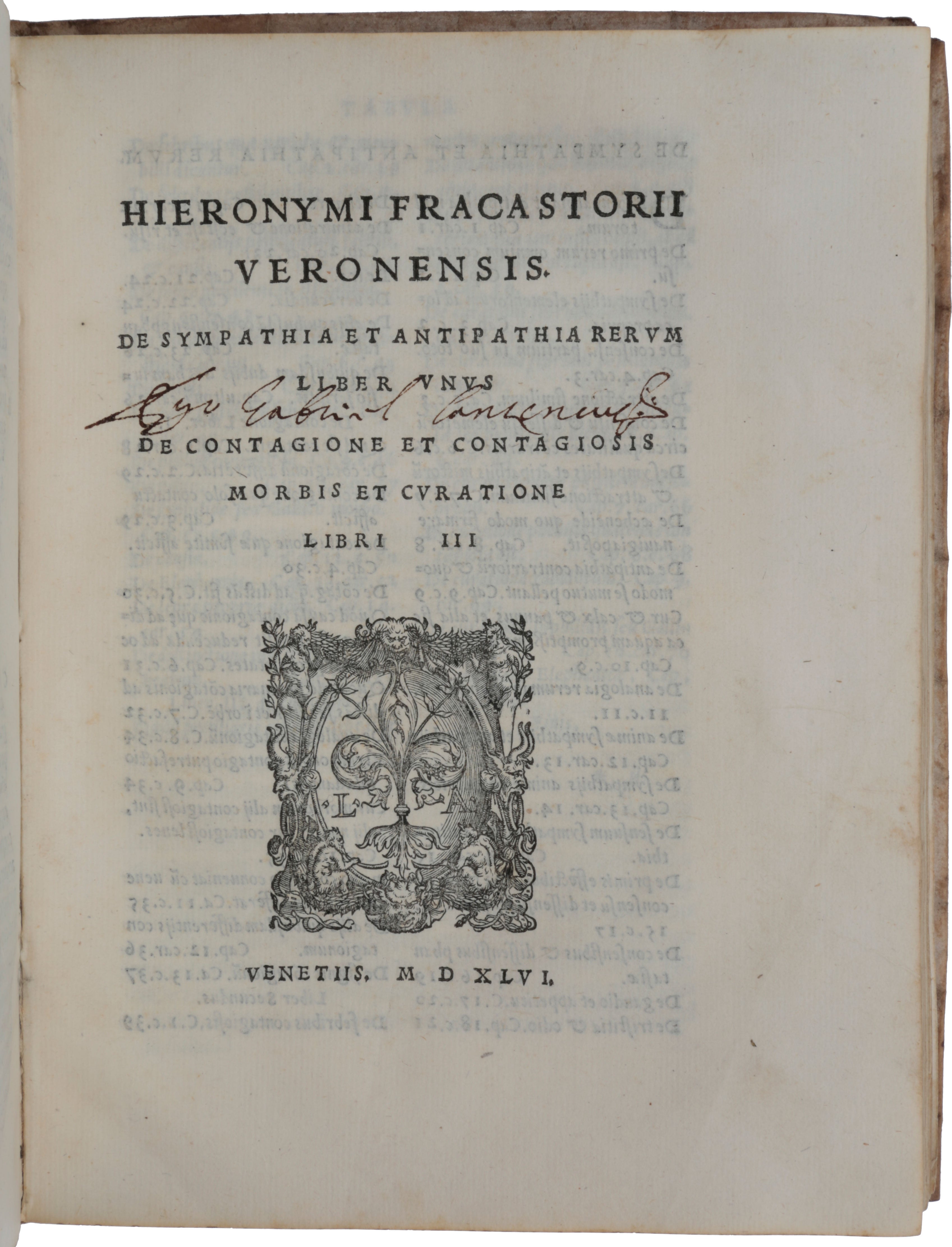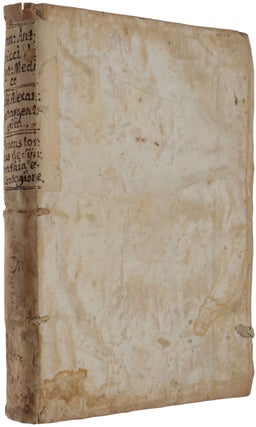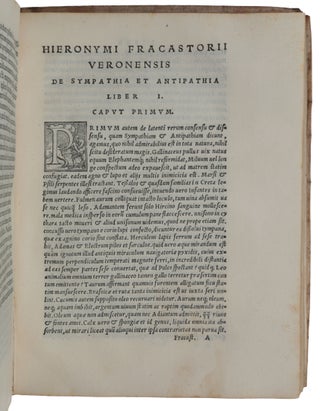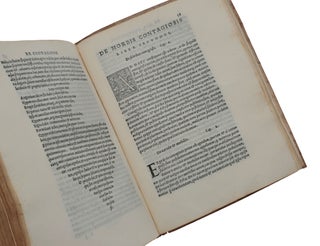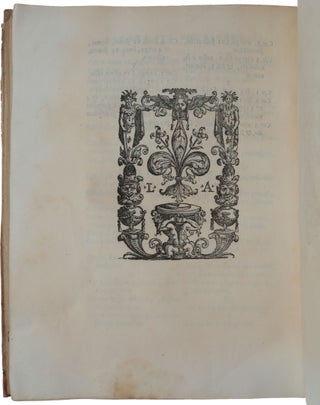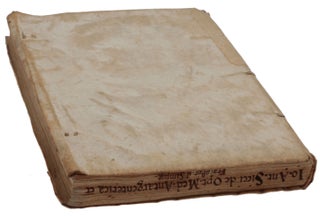De sympathia et antipathia rerum liber unus. De contagione et contagiosis morbis et curatione libri III.
Venice: Heirs of Lucantonio Giunta, 1546. First edition of Fracastoro’s most important scientific work, forming “the foundation of all modern views on the nature of infectious diseases” (Heirs of Hippocrates 101). “The first scientific definition of contagion known and a competent discussion of causes of infection. Gives a clear account of typhus” (Stillwell, The Awakening Interest in Science during the First Century of Printing, 368). Fracastoro’s “most important medical treatise, De contagione, consists of a short theoretical discourse on sympathy and antipathy in physics and a longer, more practical account of contagion and contagious diseases. Here, for the first time, was a clear description of the spread of disease by seminaria contagionum, the seeds of infection – the suggestion of the germ theory. De contagione is arranged in three ‘books.’ The first explained the mechanism of contagion, how seminaria can be carried a distance, and why only some diseases are contagious. In the second book he wrote about a series of contagious diseases. Fracastoro had made careful observations; he differentiated smallpox from measles, gave the earliest precise description of typhus, and showed that tuberculosis was contagious. He discussed rabies and syphilis and dealt with the differential diagnosis of contagious skin diseases. Finally, in the third book, he outlined the treatment of diseases covered in book two and commented on the spread and control of epidemics” (Le Fanu, Notable Medical Books). “In this treatise on epidemiology Fracastoro hypothesized that contagious diseases were caused by minute particles, spontaneously generated from certain types of putrefaction and possessing the faculties of propagation and movement. He illustrated the three means by which contagion can be spread: by simple contact, as in scabies and leprosy; by fomites or inanimate carriers, such as clothing or sheets; and at a distance without direct contact, as in plague smallpox, and like diseases, whose transmission he attributed to the action of the air, denying widespread belief in the influence of occult powers'” (Norman). “Fracastoro’s scientific thought culminates and concludes with De contagione et contagiosis morbis et curatione (1546), which assures him a lasting place in the history of epidemiology” (DSB). This copy of Fracastoro’s work is bound with two minor medical works from the same press: Giovanni Antonio Sicco, De optimo medico, 1551, and Julius Alexandrinus, Antargenterica pro Galeno, 1546. Provenance: Signed on title of each work by ‘Gabriel Canzeniusti’ (?). “The three books of Fracastoro’s De contagione form only one part of the volume as printed. Between the prefatory dedication to Cardinal Alessandro Farnese and the work itself stands a separate tract on sympathy and antipathy. The exact relationship between the two treatises is never spelled out, but both serve to attack explanations for the working of the universe in terms of ‘occult’ qualities. Far from being hidden from the scientist, the causes of, for example, magnetic attraction or repulsion could be explained logically by the principle of antipathy and sympathy. The same doctrine could also explain why lime and a sponge were both good at soaking up water, and why some bodies were more receptive than others to particular diseases. The action of certain contagions was explicitly compared by Fracastoro to that of poisons or the deadly catablepha, whose gaze was believed to be fatal and whose virulence could be attributed to the antipathy of its ‘spiritual form’ to the spirits of the human body. In short, although Fracastoro did not explicitly make the connection, his tract On Sympathy provided a general theoretical framework for the discussion of the specific example of contagion and contagious disease. “This discussion involved both theory and practice. The first two books of De contagione offered a general theory of contagion, followed by a discussion of a number of different contagious diseases, while the third book dealt with their treatment and cure. The treatise opened with a definition of contagion that was far from unique to Fracastoro. Contagion was, so he stated, ‘a similar corruption of the substance of a particular combination which passes from one thing to another and is originally caused by the infection of the imperceptible parts.’ In other words, like could only corrupt like; contagion involved the transmission of a corrupt substance; and infection and corruption began at the most fundamental level of the body’s constituents, the various combinations that made up each individual part of the body, beyond the reach of human perception. In that sense, the process of contagion was occult, but it could be revealed by sound reasoning. “More striking than this definition is Fracastoro’s division of contagion into three types: by direct contact, by indirect contact through fomites, and at a distance. The first and third types had long been familiar, and Fracastoro was far from alone in incriminating such intermediaries as clothing and wood. But e appears to have been the first to use the word fomes as a technical term for the substance deposited on these intermediaries and to describe the transferred infective agent as ‘seedlets of contagion’ (seminaria contagionis). Both Galen and his medieval translators had used the phrase ‘seeds of disease’, albeit very occasionally, and Fracastoro himself in his poem Syphilis had talked of the seeds of disease ‘creeping’ into the body. But it is hard to interpret these allusions and metaphors precisely, even harder to reconstruct a theory of contagion and of seeds solely from within the poem. Such hints as exist were extended by Fracastoro in a prose tract on syphilis, probably written in the early 1530s. In it he oscillated between calling the infective agents of syphilis ‘seeds’, ‘seedlets’, or simply ‘first principles’ of contagion. His discussion was naturally confined to syphilis, and his account of the general principles behind the seeds was correspondingly limited. “By the late 1530s, however, Fracastoro had elaborated an explanation for the differences between the abilities of the seeds to infect in terms of their various elemental properties. The combination that made up the seed had to be sufficiently strong to survive the transfer and viscous enough to remain in or on an intermediary, which itself had to be of an appropriate kind to for the seed to stick. The seeds that infected at a distance needed both a more powerful combination – or else they would break up in transit – and a greater subtlety, in order to penetrate their host. Some seeds, on adhering to the neighboring humors, might begin at once to propagate and multiple until the whole mass of humors was affected. Others were drawn inward into the body by inspiration of the air and, once deep in the body, brought about a dissolution by exciting, like poison, an antipathetic movement of spirits (or life forces) away from their site. Still other seeds might enter through the smaller blood vessels and the periphery and pass along them to the heart and other major organs. Once in the body, their action depended on their analogies and affinities, for, it was well known, some individuals and some parts of the body were likely to be attacked by some contagions and not by others. Phthisis did not attack the eyes. The type of seed also determined the type of disease. The seeds of syphilis were sharper and harder than those of leprosy and were thus able to penetrate into the deepest parts of the body. Once there, they would initiate putrefaction, the rotting and dissolution of the parts. “The relationship between putrefaction and contagion occupies many pages in Fracastoro’s discussion. In Book 1, while accepting contagion as a type of putrefaction, he nevertheless denied that the seeds that produced the contagious putrefaction had themselves to be putrid; their very presence within the host’s body might be enough to initiate putrefaction. Unlike Giambattista da Monte, a professor of medicine at Padua and a fellow townsman, Fracastoro did not believe that putrefaction of the humors by itself was enough to cause contagion and plague, for, so he argued, this offered no explanation for the transmissibility of contagious disease. By contracts, his own principle of seeds endowed with a special method of causing putrefaction answered all the questions. “But how were these seeds created? Normally they were engendered and propagated within the host, although, in certain circumstances, they might also be produced in the sky by the heating action of the heavenly bodies or as a result of a particular planetary conjunction. This was an area crying out for further research, but for syphilis, at any rate, Fracastoro was convinced of a sidereal origin. In his opinion, it was a totally new disease, the result of a change in the disposition of the air, since without such a potent cause, it would be hard to imagine such a slowly acting contagion spreading so quickly. The idea of a new disease or of diseases with a relatively localized spread did not trouble him, for, so he argued, the movements of the planets and the constant changes in the atmosphere lent themselves easily to such transient creations. An aerial cause also helped to explain the changes in the course of syphilis over the years, for with the departure of the original atmospheric conditions, the disease had settled down to its own life cycle. After half a century, it was now in its old age and might in time die or be too weak to propagate itself. But, equally, its disappearance was no guarantee that the same atmospheric conditions would not recur and recreate identical seeds. After all, in certain parts of the world, notably Hispaniola, syphilis was endemic because of the permanence of favourable atmospheric conditions. “Such theoretical questions took up most of the first two books of De contagione, and Fracastoro confined to the last book his suggestions for the treatment of the (relatively few) contagious diseases he had identified in Book 2. His general principles involved the extinction of the seminaria, stopping them from propagating, expelling them from the body or repelling them by means of antidotes that were ‘spiritually antipathetic’ to them. Alternatively, one might dry the body in order to stop the rot – for example, by administering various powders and preservatives – or one might remove the putrefied substance entirely, by drugs, caustics or surgery. The precise remedy depended, of course, on both the disease and the patient, but Fracastoro was confident enough to lay down general rules for treatment, as well as more specific injunctions against particular contagious diseases. Not surprisingly, given the genesis of the treatise, Fracastoro gave most space to the treatment and cure of syphilis. His theories, however, were cited more often by contemporaries in their discussions of plague, although this perhaps reflects only the relative popularity of plague tracts” (Nutton, pp. 199-202). Hieronymi Fracastorii, or Girolamo Fracastoro (1483-1553), was one of the most important people at the center of the intellectual scene of the early sixteenth century, not only for the famous poem Syphils sive Morbus Gallicus (1530), but also for his proposal of an alternative to the Ptolemaic astronomical system, developed a few years before the Copernican revolution, based on the renewal of homocentrism. Fracastoro was a true Italian Renaissance man: he excelled in literature, poetry, music, geography, geology, philosophy, astronomy and, of course, medicine. At the early age of 24 years old he became professor of logic and, soon afterward, of anatomy at the University of Padua where he met Nicolas Copernicus (1473-1543), who entered the university to study medicine in 1501. Pope Paul III, in 1545, named Fracastoro doctor of the Council of Trent. In this role Fracastoro himself was instrumental in moving the seat of the council from Trent to Bologna, due to an outbreak of typhus, a disease that was first described in his book De Contagione. On August 6, 1553, Fracastoro suffered a stroke and expired the same day, in his villa at Incaffi, Italy. Adams F-821; Durling 1636; Garrison-Morton 2528; Heirs of Hippocrates 101; Norman 827; Osler 2652; Waller 3163; Wellcome 5966. Nutton, ‘The reception of Fracastoro’s theory of contagion: the seed that fell among thorns?’ pp. 196-234 in: Renaissance Medical Learning: Evolution of a Tradition, 1990.
4to (205 x 157 mm), [4], 76, [4, including terminal blank] ff., with woodcut printer's device on title and colophon leaf and woodcut initials and 3 woodcut diagrams in text. Contemporary reverse limp vellum, paper label with manuscript title on spine (binding slightly soiled, lacking two pairs of ties). A fine, crisp, clean copy, bound with two other medical works from the same press.
Item #5228
Price: $12,500.00

